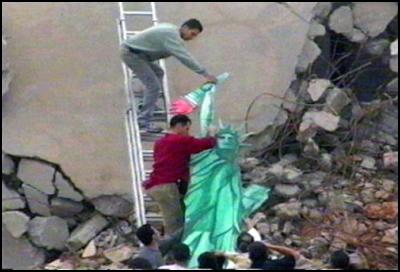Sonia Nettnin: Film Review - Siege
Film Review: SIEGE
By Sonia Nettnin

Artists express their
thoughts and feelings about military occupation. In this
photo, their work of art symbolizes the absence of freedom
in Palestinian life. It depicts the U.S. Statue of Liberty.
Since U.S. tax dollars fund support Israel, this photo
captures several meanings and Messages (Photo courtesy of
Chicago Palestine Film Festival).
Israeli soldiers left their mark.
In the Ministry of Culture’s office, they draped the windows with barbed wire. On the floor, crates filled with bottles of urine. Feces on the rug. The inside of a Xerox machine smeared brown.
Finch birds chirped in the bushes.
SIEGE (A Writer’s Diary) is a documentary about the Israeli invasions of Ramallah in 2002. This weekend, the film will have its final screening at the third annual Chicago Palestine Film Festival.
During these incursions, Liana Badr filmed (in real time) what the Palestinian people found after Israeli forces lifted curfews.
“Is it Monday or Tuesday?” she asked. “It feels like I am on an island surrounded by explosions.”
The sound of a tank rolled down the street and a soldier’s voice echoed on a loudspeaker.
Since Badr filmed her experience, it is from the first-person point of view. While she traveled through the city, she recorded peoples’ reactions to smashed cars – upside down – on piles of rubble. It is a filmed account of life under siege. Badr references month and date, so the time of year orients viewers.
Badr filmed from her home and used the view from her window. Careful – the snipers. She moved toward the window and she walked away from it, so she made this point clear.
Home confinement caused loss of sensory experience. The scent of spring flowers helped her regain her sense of smell. After soldiers lifted the curfew, people moved in the streets. Their first priority is food and water.
Israeli forces smashed ATM machines and they shattered storefront windows.
The film is like a collage, because Badr moves from scene to image. This technique reinforces the documentary’s objective: life under siege is devastation. It turns peoples’ environment upside down. Violence is about emotional destruction and humiliation.
The film’s technique presents damage through artistic expression. While Badr filmed the broken windows and the demolished buildings, she narrated additional information. As a result, the images have a context.
For example, she filmed her office. Then she explained the soldier’s used her office as a sniper location. As she moved through the building, she said they turned offices into soldiers’ bunkers. Therefore, the film is a historical record of the logistics behind the violence and the damage cause by these invasions.
Ripped up streets, razed pine trees, cars bulldozed into roadblocks. On the ground sideways, palm trees.
Insult upon injury.
Office interiors revealed graffiti on the walls, computer hardware removed and cabinet drawers on the floor. Paper files covered rugs. Files replaced in cabinets with new material – Israel’s flag dangled out of drawer tops.
Badr zoomed into the darkness of a large vase…contents predictable.
In the face of these atrocities, children flew white kites in the sky.
Some of the scenes have no sound. Silence elicits responses in peoples’ mind. In the theater, people whispered into each others’ ears. Some people walked out of the theater. Sometimes, reality stings . . . like salt on a bloody wound.
“I wonder how the New Year is going to be?” she asked.
As I watched this film, I asked myself: “If they do this to property, what happens in the prisons?”
The documentary included a visit by a U.S. actress.
The Creative Women’s Forum of 2003 contributed to the film.
Sonia Nettnin is a freelance writer. Her articles and reviews demonstrate civic journalism, with a focus on international social, economic, humanitarian, gender, and political issues. Media coverage of conflicts from these perspectives develops awareness in public opinion.
Nettnin received her bachelor's degree in English literature and writing. She did master's work in journalism. Moreover, Nettnin approaches her writing from a working woman's perspective, since working began for her at an early age.
She is a poet, a violinist and she studied professional dance. As a writer, the arts are an integral part of her sensibility. Her work has been published in the Palestine Chronicle, Scoop Media and the Washington Report on Middle East Affairs. She lives in Chicago.


 Gordon Campbell: On The Americanising Of NZ’s Public Health System
Gordon Campbell: On The Americanising Of NZ’s Public Health System Ian Powell: Trumpian Health Leadership
Ian Powell: Trumpian Health Leadership Eugene Doyle: Disruption - Historians Challenge Russophobic Propaganda
Eugene Doyle: Disruption - Historians Challenge Russophobic Propaganda Ramzy Baroud: War, Doublethink, And The Struggle For Survival - Geopolitics Of The Gaza Genocide
Ramzy Baroud: War, Doublethink, And The Struggle For Survival - Geopolitics Of The Gaza Genocide Binoy Kampmark: Authoritarian Politics - Netanyahu’s War On Israeli Institutions
Binoy Kampmark: Authoritarian Politics - Netanyahu’s War On Israeli Institutions Keith Rankin: Learning The Correct Lessons From World War Two In Europe
Keith Rankin: Learning The Correct Lessons From World War Two In Europe